
A lot of promising developments are happening in the OLED space this year, especially for large display devices and VR/AR applications. According to projections by market analyst DSCC, the growth trajectory of OLED material revenue is poised to ascend from $1.4 billion in 2023 to a stunning $2.18 billion by the year 2027. If you are interested in the technology, it's essential to recognize that not all OLED displays are the same. Learning about these differences can help you make smart choices when you buy devices with OLED screens.
So, let's jump in and find out how these cool advancements are shaping up the future of digital displays.
To understand different OLED technologies, it is essential to know the basic structure of OLED displays. We all know that OLED displays are self-emissive displays that use organic materials to emit light when an electrical current is applied, and unlike LCD displays, they don't require a backlight.
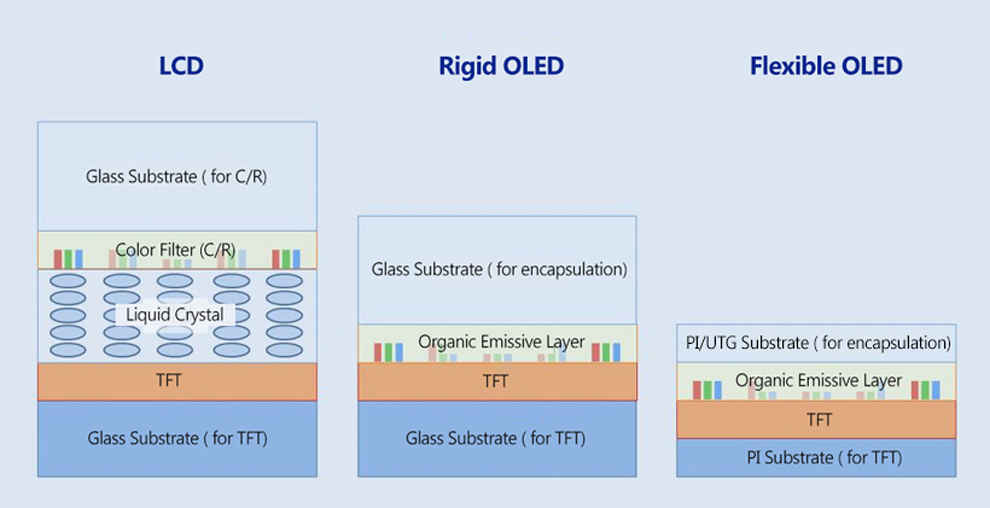
Image source: Samsung
If we were to oversimplify things for the sake of understanding, the basic structure of an OLED panel could be broadly divided into an emission layer and a TFT backplane.
The emission layer comprises the OLED material responsible for emitting light. It is, of course, supported by various other layers that improve the efficiency of the process, including the Hole Injection Layer (HIL), Hole Transport Layer (HTL), Electron Injection Layer (EIL) and Electron Transport Layer (ETL).
The TFT (Thin Film Transistors) backplane is constructed on a glass or PI substrate and essentially contains all the circuits necessary to address subpixels. The backplane includes switching TFTs to turn subpixels on/off and driving TFTs to maintain their brightness. These TFT circuits become more complex as the resolution increases.
To support responsive high-resolution and high-refresh-rate displays, electrons need to move rapidly through TFT circuits. This is why the material used for these TFTs plays an important role in determining display performance. So, when we are talking about words like Ai-silicon, LTPS, or LTPO - it’s the backplane technology that is being referred to.
It's also important to note that all OLED displays used in commercial devices have a TFT backplane and are thus referred to as Active Matrix OLED or AMOLED displays. Nearly all LCD displays used in consumer devices are also Active Matrix LCDs or AMLCDs. So, whether a manufacturer uses AMOLED or OLED to describe its displays, they are all AMOLED displays. Passive matrix OLED displays are no longer used in mainstream consumer devices including phones, TVs, or tablets.
The OLED structure shown in the image above is primarily for a basic RGB OLED panel. Other types of OLED displays can have additional layers. For instance, White OLED displays, commonly used in TVs, feature a colour filter layer and a polarizer that prevents external light from being reflected by the panel.
Also Read: What are MicroLED displays? How are they better than OLED or mini LED displays?
RGB OLEDs are the OLEDs used in our smartphones. They have separate Red, Green and Blue subpixels where the OLED material is deposited using a Fine Metal Mask or FMM
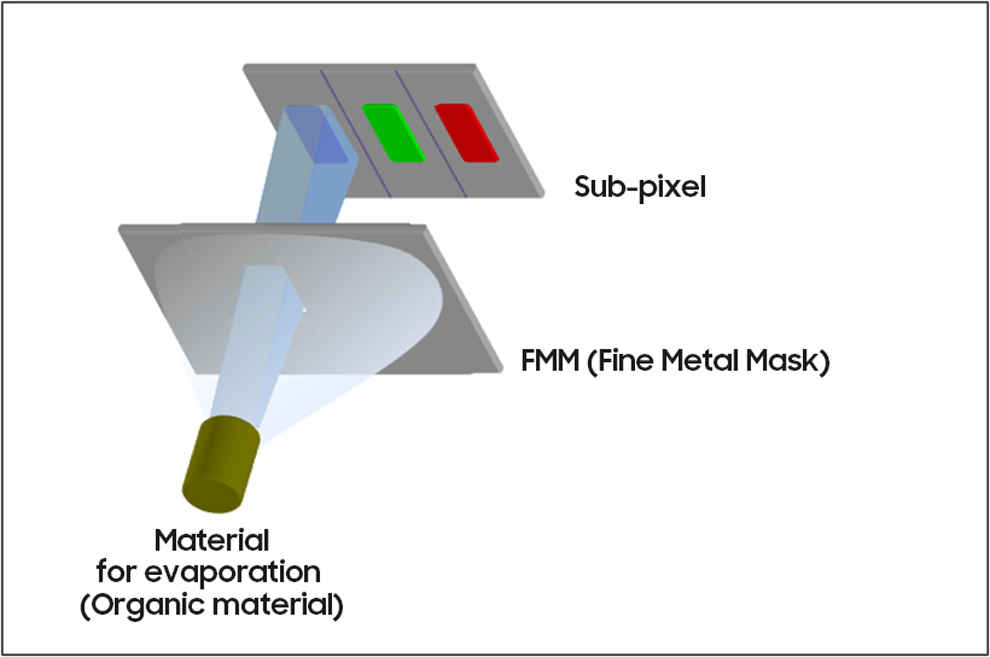
Image source: Samsung
These displays have a single layer of OLED emissive material, which means the display lifetime isn’t very long but is still suitable for the usual smartphone lifecycle.
It’s incredibly challenging to manufacture large-screen devices like TVs using the same technology. Samsung launched its one and only TV with true RGB OLED, the Samsung KE55S9C with a curved screen in 2013. The company later switched to QLEDs as its primary TV technology for several years.
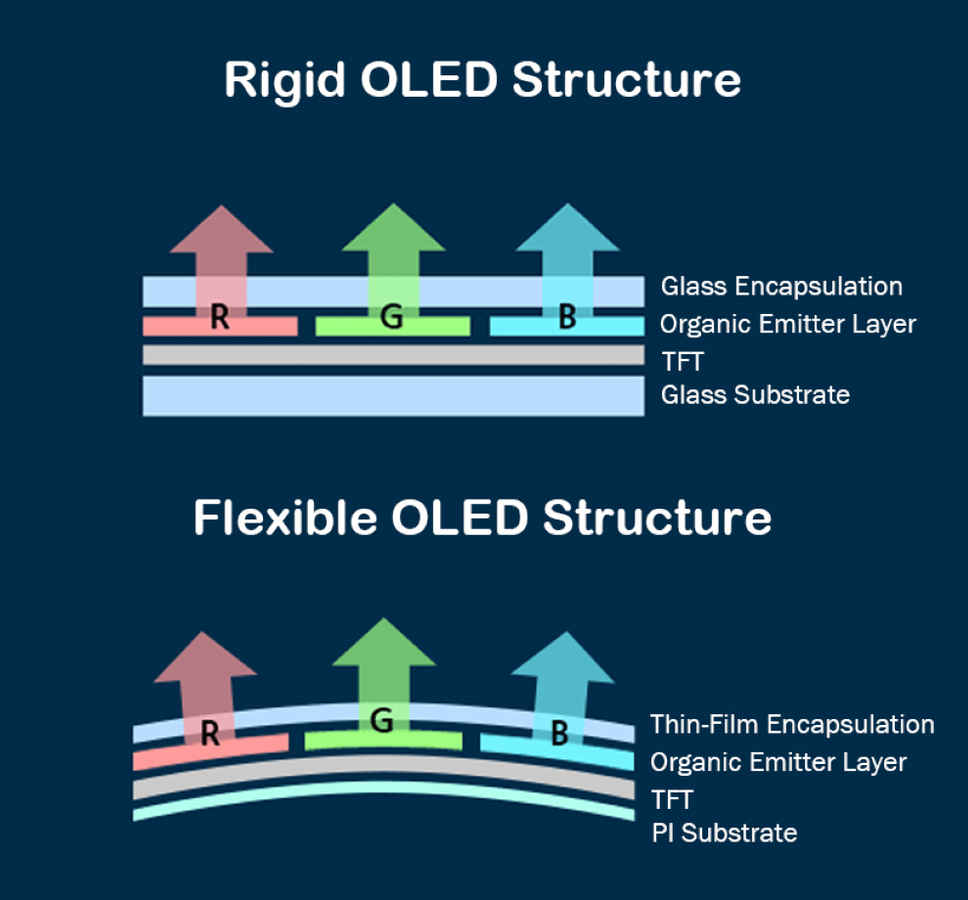
While we are talking about phones, we will briefly address Flexible OLED and LTPO OLEDs. Flexible OLEDs in phones are similar to rGB OLED but instead of a glass substrate, they use a flexible polyimide (PI) material as their base. These displays also use Thin-Film Encapsulation (TFE) technology to protect the display instead of regular encapsulation.
LTPO ( low-temperature polycrystalline oxide) displays are known to be fast and responsive OLED displays for phones. These displays combine LTPS and IGZO material in the TFT backplane. LTPS is used for switching TFTs and IGZO is used for driving TFTs. Combining the benefits of both, these displays are responsive and relatively more power-efficient than regular LTPS OLED displays and are thus increasingly used in high-end phones with variable refresh rates.
Tandem OLED broadly refers to any OLED panel that stacks multiple layers of emitting material. This term is popularly referred to new OLED displays being developed by Samsung and LG for high-end tablets like iPad Pro (2024) and perhaps also for upgrading MacBook Pro models that currently use Mini-LED displays.
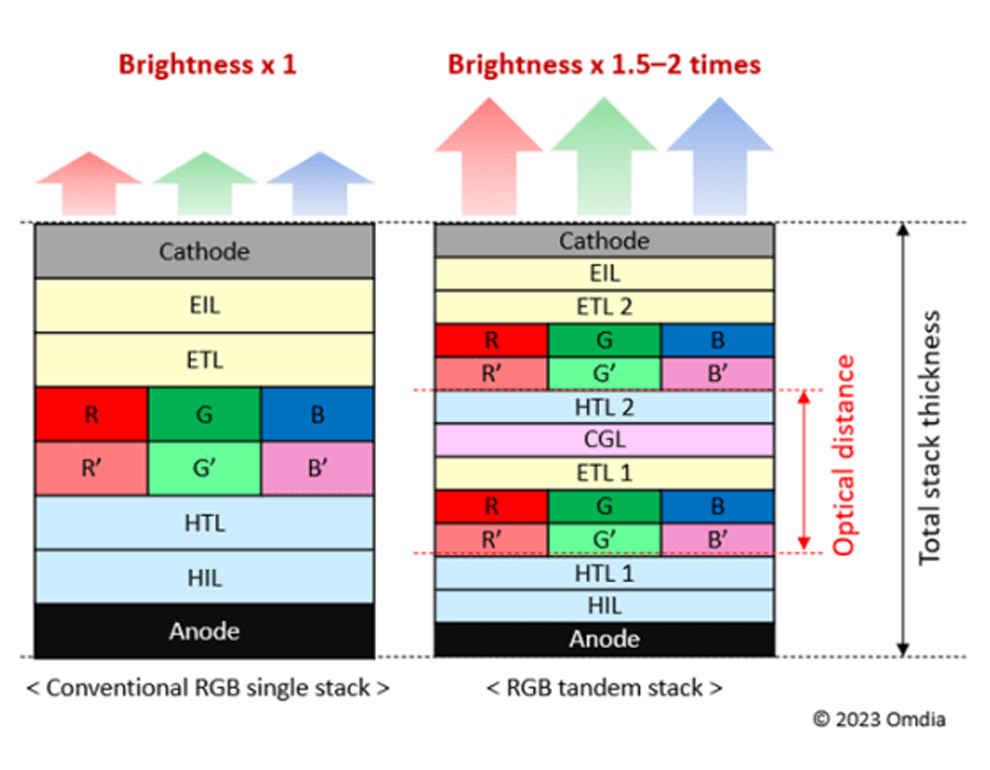
Source: Omdia
Using a two-stack structure for OLED material will help improve the brightness and life span of these displays, which are essential attributes for tablets and laptops that are expected to have a longer lifespan than smartphones. Initial reports claim 2x brightness and 4x longer lifetime as compared to single-stack OLEDs.
These displays will use Thin Film Encapsulation (TFE) used in Flexible OLED displays to protect them from moisture and dust, but on a solid glass substrate instead of a flexible substrate. This is why LG and Samsung are also reportedly calling them Hybrid displays.
eLEAP stands for Environment positive, Lithography with maskless deposition, Extreme long life, Low power, and High luminance, Any shape Patterning and these displays are being manufactured by JDI.
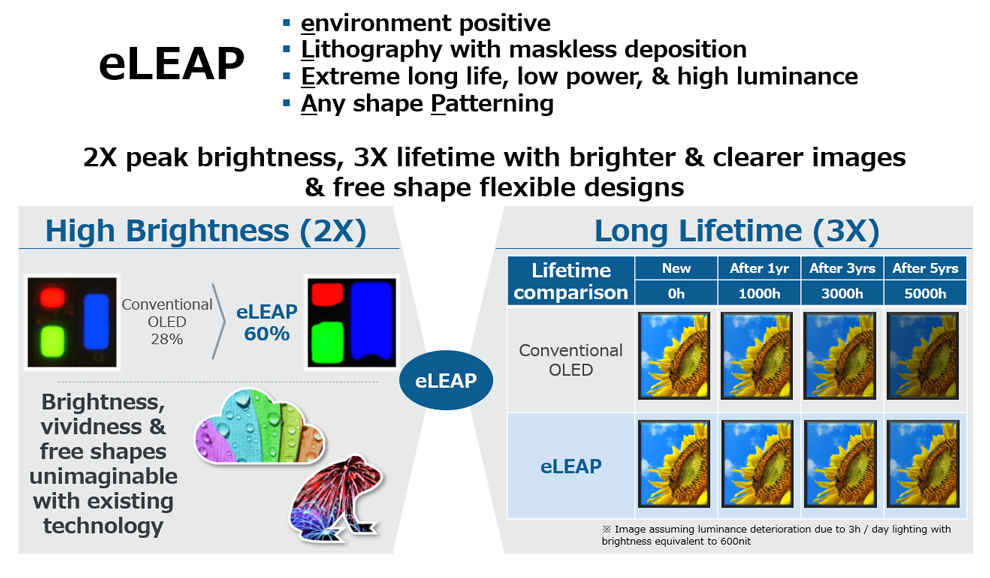
Source: JDI
The critical point is L or Lithography with maskless deposition. As we discussed RGB OLEDs comprises self-emissive Red, Green, and Blue subpixels that are deposited on a substrate via a fine metal mask (FMM) through a process called evaporation.
Once the substrate is deposited, the mask is chemically removed by a process called wet etching which involves immersing the panel in chemical solutions that dissolve the mask but don’t affect the emissive material. The deposition process is then repeated for the other two subpixels.
JDI claims that around 150K tons of mask-cleaning chemicals are used every year and thus eLEAP panels that eliminate the mask altogether are environment friendly.
But eliminating the Fine Metal Mask also helps achieve a significantly larger aperture ratio of 60% compared to 28% in OLEDs manufactured using a fine metal mask. It also enables the manufacturing of flexible, any-shape OLED displays!
The aperture ratio is one of the key indicators of OLED display performance. A higher aperture ratio in a display allows for a higher brightness level to be achieved using the same amount of power. This means that a longer display lifespan can be achieved since a large amount of power usage can often reduce the lifespan of a display.
For the eLEAP displays, JDI claims 2x the efficiency, 2x the peak brightness, and 3x the lifetime as compared to the existing OLED panels. These displays are expected to hit mass production in 2025 and could potentially be used in popular Samsung and Apple devices.
White OLED displays are most prominent in OLED televisions. These displays have four sub-pixels - White, Green, Blue, and Red out of which any three are active at a given time. White OLEDs don’t have individual OLED emitters for every subpixel as OLED displays on our phones and tablets do, and instead use a stack to produce white light across all pixels and then use a colour filter to make red, green and blue sub-pixels. These have a bottom emission structure, which means a portion of the light is also blocked by backplane which lies between the emission stack and viewers.
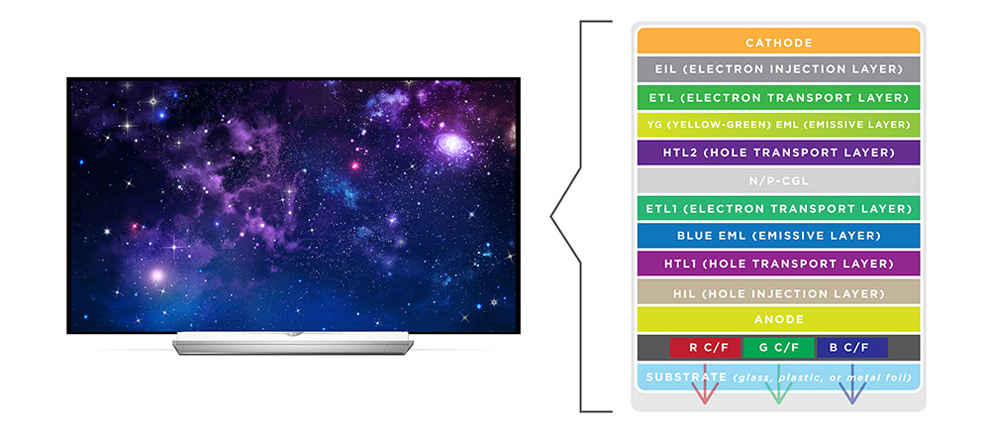
Source: Universal Display Corporation
The tandem stack in White OLEDs manufactured by LG Displays includes two layers of blue, red, yellow-green and green. The combined white light from these is then passed through a colour-filter layer to get the red-green-blue-white subpixels.
The latest 3rd Generation of White OLEDs is also called MLA OLEDs. These displays use a microlens array and LG’s meta booster technology that enables it to improve the brightness by up to 60 per cent and to widen the viewing angle by up to 30 per cent.
Also Read: QD-OLED vs MLA OLED vs OLED Ex vs OLED WBE vs OLED WBC TV panels: What's the difference?
QD-OLED displays used in TVs like Sony A95K and Samsung Q95C have a similar stacked structure as white OLED, but there is one significant difference. The colour filter layer at the top is replaced by an ink-jet printed quantum-dot conversion layer.
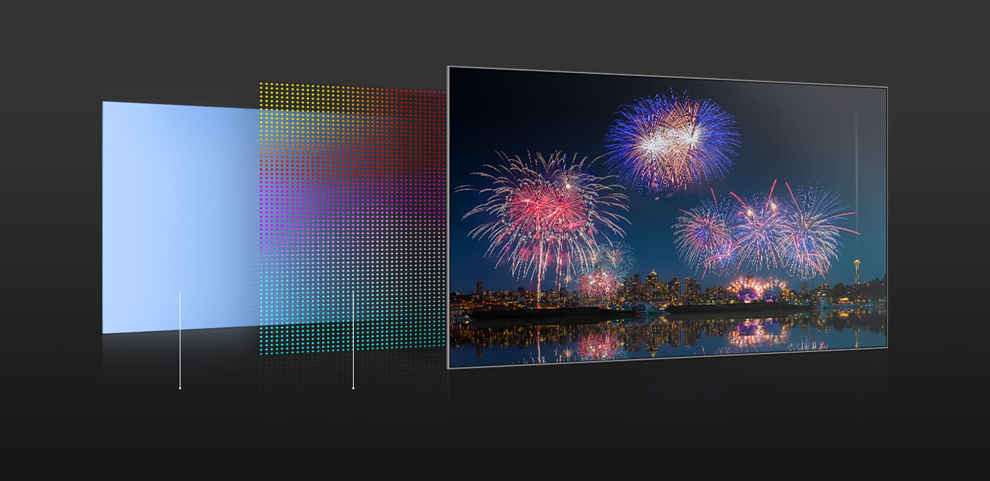
Multiple stacked OLED emission layers produce a blue light that excites red and green quantum dots to emit red and green light. The blue light is passed as is through the blue sub-pixel.
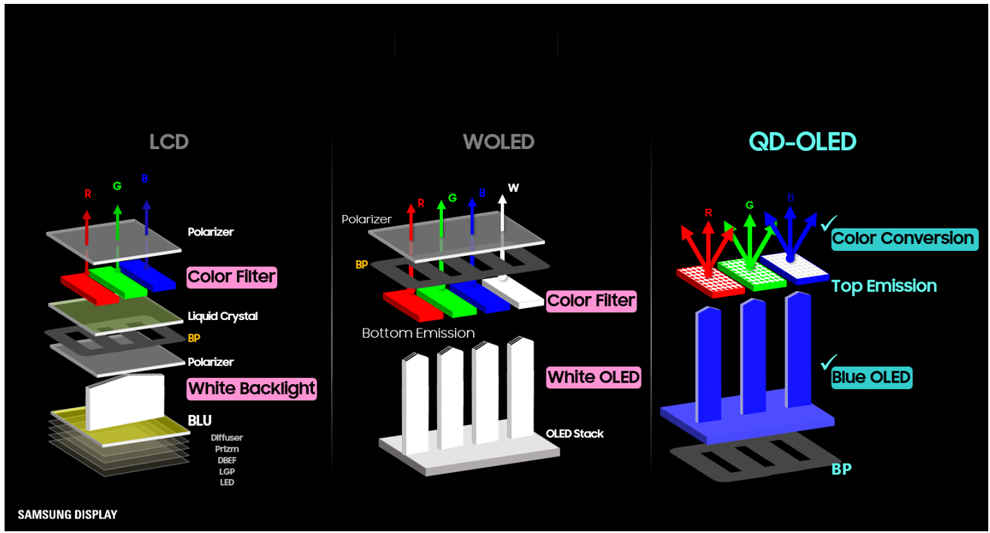
Image Source: Samsung Displays
The display thus essentially behaves as RGB OLED, because there is no loss in quantum efficiency when blue light excites quantum dots. What this means is that the intensity of green and red light emitted by quantum dots is the same as that of blue light that excites them.
Since no White sub-pixel is needed to boost brightness, QD-OLED displays can achieve a wider colour volume and get brighter and enhance performance in the near-black region.
Printed OLEDs are true RGB OLEDs that are simpler to manufacture in large sizes. The red, blue and green OLED material in the emission layer is simply printed on the substrate with wells that hold the OLED material ink.
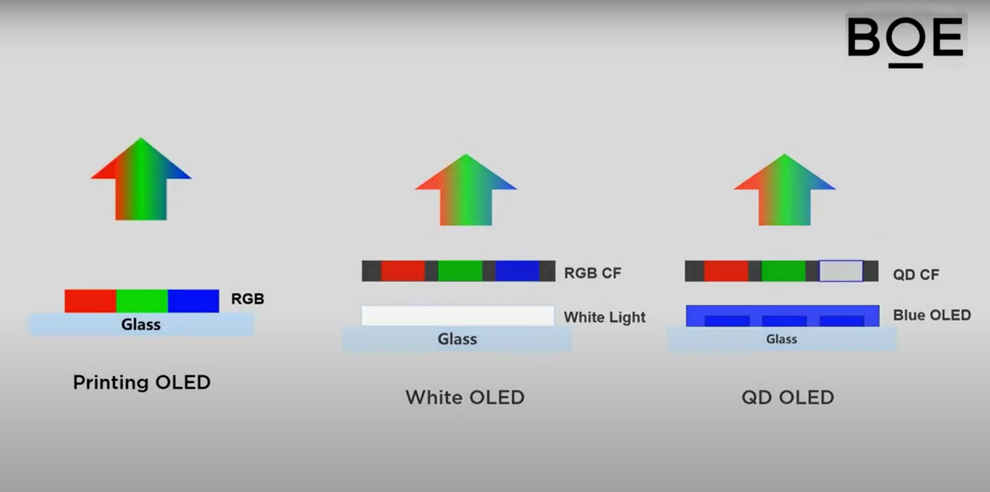
Image source: BOE
Printed OLEDs have been used in several premium and professional OLED monitors including LG OLED Pro 4K which was allegedly used by several professional colorists working from home during the pandemic. However, JOLED, the company supplying these panels filed for bankruptcy in early 2023.
This however isn’t the end of road for printed OLEDs. At Display Week 2023, TCL CSOT showcased several innovative concepts of Printed OLEDs including an 8K Folding TV! The company still doesn’t have a production line for Inkjet printed OLEDs yet so it will still take some time for such TVs to actually come to the consumer market.
VR headsets with micro OLED displays like Varjo Aero and Big Screen Beyond have existed for a while, but it was the Apple Vision Pro headset that popularized the technology and gave it a massive push. Apple can also be credited with using larger and sharper micro OLED displays with 23 million pixels spread across two micro OLED display panels.
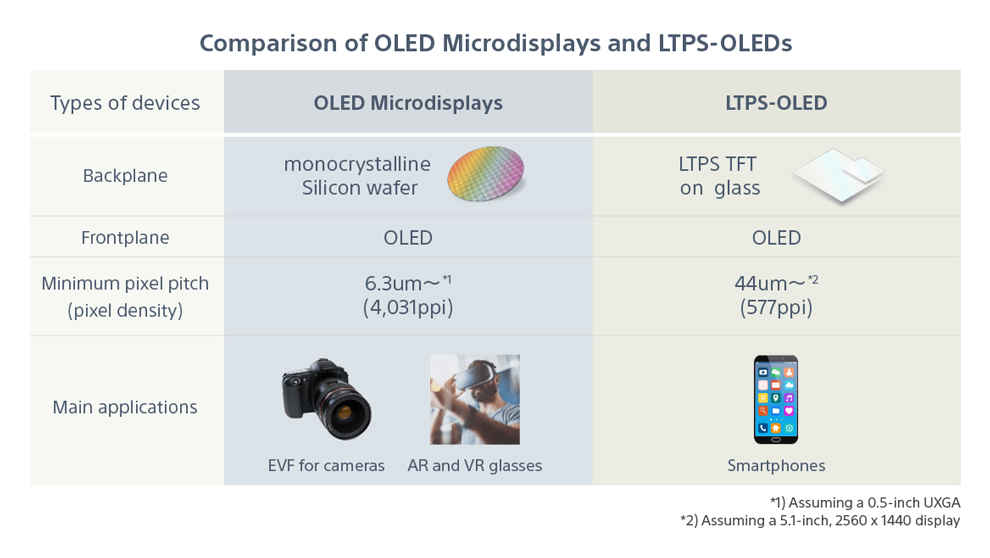
Image source: Sony
Micro OLED displays don’t use a glass substrate with a TFT backplane. The backplane is instead manufactured in a semiconductor fab, though probably not on as cutting-edge process nodes as our smartphone chipsets.
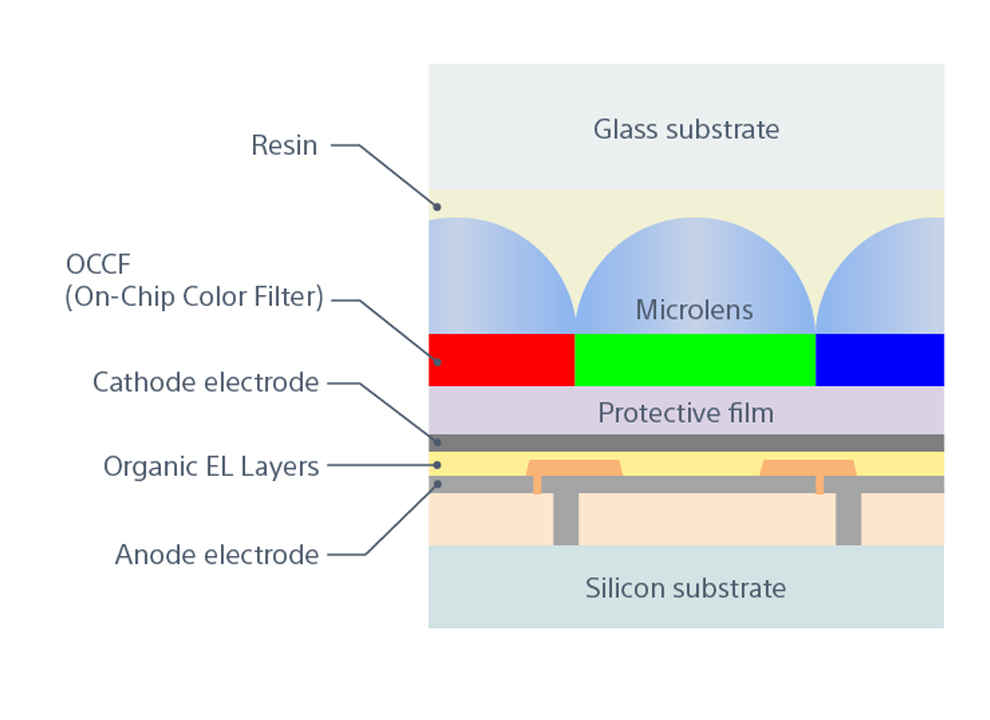
Image source: Sony
OLED material is then deposited on the Silicon backplane. According to DSCC, the display used on Apple Vision Pro has a backplane manufactured by TSMC and the emission layer is manufactured by Sony. the company uses a white OLED stack with a microLens array and a colour filter array on top, kind of like white OLEDs on TV. But unlike TVs, the micro OLED displays for VR don’t require any anti-reflective coating or polarizer. Sony has also moved the colour filter closer to the OLED stack to improve efficiency.
All of these factors enable micro OLED displays to get significantly brighter. In fact, imagine has a display that gets up to 15000 nits bright! Such high brightness is needed to balance the significant loss of efficiency when the light passes through optical lenses in VR headsets.
Phosphorescent OLEDs or PHOLEDs are expected to drastically enhance the brightness, colours and efficiency of OLED displays used in our TVs, tablets, laptops and even smartphones.
Luminance is the phenomenon where OLED material emits light when subjected to electric current. Basically, there are two kinds of luminances used in OLED display - Phosphorescence and fluorescence.
Florescence is less efficient and results in 25% energy as light and a loss of 75% energy as heat. This is also the kind of luminance used in large-screen OLED displays today. Phosphorescent OLED, on the other hand, can theoretically be 100% efficient and this higher power efficiency can be used to drive higher brightness.
Phosphorescent Red and Green emitters were developed more than a decade ago, but Blue Florescent pixel has remained a bottleneck in OLED development for a long time. Manufacturers have to resort to techniques like using a larger Blue subpixel in single-stack OLED displays or using multiple Blue emitter stacks.
Now, the Blue PHOLED emitter has been developed by Universal Display Corporation (UDC) and will soon be ready for mass manufacturing. Major OLED display makers Samsung and LG are reportedly looking into the possibilities and we could see the first gen PHOLED displays as early as 2025










